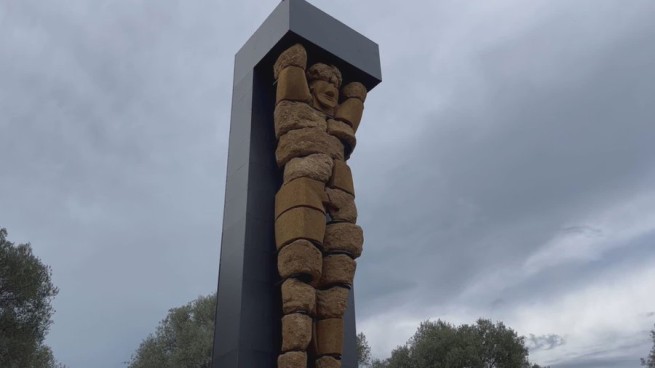An 8-meter-tall statue of Atlas that rested for centuries among the ancient ruins of Acraganta in Sicily has been restored.
The statue dates from the fifth century BC and is located in the famous Valley of the Temples in a temple believed to have been dedicated to Zeus. The eight-metre tall colossal statue has been restored and pieced together after 20 years of archaeological efforts, the Guardian reports.
The statue was one of nearly 38 that adorned the Temple of Zeus, which is considered the largest Doric temple ever built, despite the fact that it was never completed.
“The Atlas will become one of the most important attractions in the Valley of the Temples” said Francesco Paolo Scarpignato, a heritage assessor, in a joint statement with Sicily Governor Renato Stifani. “We will finally be able to present this grandiose work to the international community,” he said.
The statue was reconstructed by taking sandstone blocks and placing each piece on shelves attached to a metal structure. The statue was discovered in 1812 by Charles R. Cockerell, a young British architect who visited Akragantas to explore the ruins of the ancient city, founded around 582 BC.
As the Guardian reports, Cockerell was one of the first to realize that the huge piece of sandstone near the old Temple of Zeus was not part of the pediment of the sanctuary, but Atlas statue headwhich served as a telamon, or support column.
https://www.youtube.com/watch?v=n_CoYziBp-Y
In Greek mythology, Atlas was a titan or god who was forced to lift the sky on his shoulders after being defeated by Zeus. Cockerell later discovered other parts of the statues. According to archaeologists, the atlases were on the outside of the Temple of Zeus to support the temple and help support the entablature of the entire temple, which was never completed because the city was conquered by the Carthaginians.
Over time, the temple was destroyed by earthquakes, and in the 18th century its materials were taken by local residents to build buildings in the city and in Porto Empedocle.
In 2004, an extensive research campaign began in the Valley of the Temples park under the leadership of the German Archaeological Institute of Rome and Heinz-Jürgen Beste. This research not only provided new information about the monument, but also led to a careful inventory of 90 more fragments belonging to at least eight different atlases, as well as to the decision to assemble a new atlas piece by piece and install it vertically in front of the Temple of Zeus.
Roberto Sciarratta, director of the Valley of the Temples Park, said: “This atlas is one of the most important in the Valley of the Temples. The idea was to move one of these atlases in front of the temple to serve as a guardian for the structure dedicated to the father of the gods.”
The Valley of the Temples is now a UNESCO World Heritage Site and the largest archaeological park in the world, covering 1,600 hectares and including the ruins of seven temples, city walls, entrance gates, market, Roman forum, as well as necropolises and sanctuaries.
Valley of the Temples (Valle dei Templi) – one of the most important examples of ancient Greek art and architecture Magna Graecia or Magna Graecia and one of the main attractions of Sicily. The term “valley” is a misnomer, as the site is located on a ridge outside the city of Agrigento. Since 1997, the entire territory has been included in the UNESCO World Heritage List.
The statue rises above the remains of the temple itself – a wide stone platform strewn with fallen columns and stone blocks. “The work we do at Atlas and at the Olympia site is part of our mission to protect and enhance the Valley of the Temples,” Sciarratta said.
https://www.youtube.com/watch?v=NZttoIsU3Cc
City `s history
Akraganta was founded on a plateau overlooking the sea, with two neighboring rivers and a ridge acting as a natural fortification. Ancient Greek settlers arrived from Gela (582 BC – 580 BC) and gave the new settlement the name “Akragas” after the nearby river of the same name.
The city developed rapidly and became one of the leading cities of Magna Graecia. In the 6th century BC. e. it reached its peak when the tyrants Phalaris and Tyrone Akragantinus ruled for 16 years, and after the overthrow of Tyrone’s son Thrasideus Akragantinus, a republic was proclaimed. The population of the city at that time reached 100,000 – 200,000 inhabitants. Empedocles, an outstanding philosopher of the pre-Socratic period, was born here.
The city remained neutral in the conflict between Ancient Athens and Syracuse, but was eventually destroyed by Carthage (406 BC). Akragantas never regained its former power, having only a period of prosperity during the reign of the Corinthian general Timoleon (IV century BC), who refounded it with the help of colonists from Elea.
Phidias of Akragant became a tyrant and founded a new city on Cape Eknomo, which he called “Phidias”, modern Licata (282 BC), razed Gela to the ground and resettled the inhabitants to the new city (280 BC .).
When the First Carthaginian War broke out, the city was claimed by the Roman Republic and Carthage. The Romans besieged Akragantas (262 BC) and captured it after defeating the Carthaginians (261 BC), and then sold the entire population of the city into slavery.
The Carthaginians temporarily recaptured the city (255 BC), but according to the final peace signed between the two cities, Akragantas was ceded to Rome. Akragantas suffered significant losses during the Second Carthaginian War (218 BC – 201 BC), when both Rome and Carthage tried to gain control over it.
The Romans finally conquered it (210 BC), renamed it Agrigentum, and it enjoyed a long period of prosperity for many centuries. When Julius Caesar died (44 BC), its inhabitants received the title of Roman citizens.







More Stories
Making a mockery of the Acropolis for the sake of tourism
How Plato spent his last night – what the found papyri showed
Eurovision 2024: the first rehearsal of Marina Satti in Malmö has ended